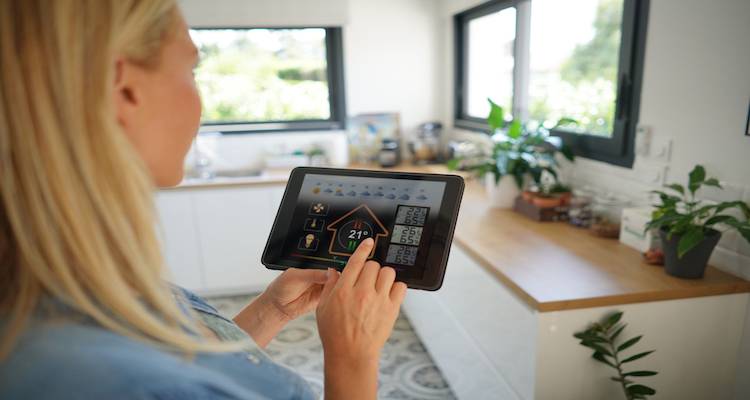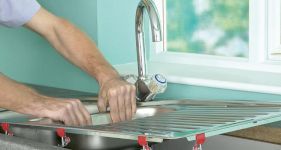Nest Thermostat Installation Cost
- The average cost of installing a Nest thermostat is £390.
- It takes roughly 30 minutes to 1 hour to install.
- A breakdown of Nest installation costs, from supply only to full installation.
- How long installation will take, as well as other smart home upgrades you can consider at the same time.
- How to find and hire a local electrician to fit your Nest thermostat.
Looking for the cost to install a Nest thermostat?
In this guide, we'll reveal all you need to know about the types of Google Nest technology on offer, as well as the cost of labour to have it installed and what other smart home upgrades you can have done simultaneously.
Already bought your Nest thermostat and just want an electrician's quote?
Look no further. MyJobQuote has thousands of professional electricians near you ready to make you a free, no obligation quote.
Or, to learn more about Nest costs first, keep reading.

£390
Table of Contents
- How Much Does Nest Thermostat Installation Cost?
- Nest Thermostat Cost (Supply Only)
- Additional Nest Thermostat Installation Costs
- Nest Thermostat Labour Costs and Timescales
- What Impacts the Cost to Install a Nest Thermostat?
- What's Involved in Installing a Nest Thermostat?
- Building Regulations & Planning Permission for Installing a Nest Thermostat
- Types of Nest Thermostat Systems
- Checklist: Hiring an Electrician for Nest Installation in the UK
- FAQs
- Sources
How Much Does Nest Thermostat Installation Cost?
Considering installing a Nest thermostat?
Nest, a division of Google, have created smart thermostats and gadgets that can be controlled remotely via a smartphone or tablet. Together with homeowners installing smart meters, they're becoming commonplace in homes across the UK for their energy and cost-saving benefits.
So, what is the cost of installing a Nest thermostat?
Installing a Nest thermostat costs £390.
For supply only, Nest thermostats cost between £199 and £219.
If you want to complete your smart home, adding a Nest Doorbell is a great option. The price of Nest doorbells ranges between £179.99 to £229 depending on your choice of wired or battery-powered.
Nest Thermostat Installation Prices
Take a look at the table below for the average Nest installation prices:
| Job Description | Cost |
|---|---|
| Installation | £160 – £200 |
| Nest Thermostat (Supply only) | £199 - £219 |
| Nest Doorbell (Supply only) | £179.99 – £229 |
Nest Thermostat Cost (Supply Only)
How much is a Nest thermostat?
A standard Nest costs between £199 and £219.
Depending on the model you choose, your Nest prices can differ:
Nest Learning Thermostat
Nest Learning Thermostats cost £219.
After using this thermostat for a week, it will recognise your living habits, and control your heating intuitively so that it's on when you need it, and off when you don't.
Since 2011, Nest estimates they have saved over 39 billion kWh of energy from this innovative technology.
The Nest Learning Thermostat also has home/away assist software that automatically regulates the temperature after you leave the house.
For example, if you leave the house for an extended period, you will turn off your hot water tank until you return.
Nest Thermostat E
The slightly lower-priced Nest thermostat - the Nest Thermostat E - costs £199.
This model doesn't have learning capabilities, but you can control it using a remote control, smartphone, tablet, laptop, or by voice using Google's Alexa assistant.
You can see these Nest prices illustrated in the table below:
| Thermostat Model | Supply Cost |
|---|---|
| Nest Learning Thermostat | £219 |
| Nest Thermostat E | £199 |
Extra Nest Installation Costs If You're Fitting Yourself
Let's now look at the tools and equipment you'll need to install your Nest thermostat yourself:
| Supply | Cost |
|---|---|
| Phillips Screwdriver | £6 – £10 |
| #2 Phillips head screwdriver | £2 – £10 |
| Power Drill | £60 – £120 |
| Spirit Level | £6 – £9 |
The primary tool you'll need is a Phillips screwdriver, which should come with your Nest thermostat, and costs between £6 and £10.
To unscrew your existing thermostat, you'll also need an appropriate size and type of screwdriver. If this is a different size to your new thermostat, you may need a #2 Phillips head screwdriver, costing £2 to £10.
If you're mounting your thermostat on the wall, you'll need a power drill. These typically cost between £60 and £120.
Lastly, a spirit level is required to ensure that your Nest is straight and perfectly placed. This will cost you between £6 and £9.
Additional Nest Thermostat Installation Costs
When you install a Nest thermostat in your home, you may decide to add a few more smart features to your home. In this section, we'll go through the additional costs that can come up during installation.
Smart Lighting
Once you've started incorporating smart home features, you'll quickly realise there are lots of optimisations you can make to help your home run smoothly. Smart lighting is just one of those.
The cost of smart lighting depends on the scale of your installation.
The average smart lighting installation costs £85, while kitting out your entire house with smart lighting can range from £3,200 to £10,5000, depending on the size.
New Boiler
If your existing boiler isn't compatible with your new Nest thermostat, it can be necessary to upgrade it.

A new boiler costs around £2,400 in the UK.
Replacing a boiler is not a simple task, and it is not a do-it-yourself project. Gas boilers are subject to stringent safety regulations regarding replacement and maintenance, and you must have a Gas Safe-registered engineer to complete a gas boiler replacement.
By replacing your old boiler with a high-efficiency boiler, you could save up to £300 per year on your home's energy bills.
Nest Thermostat Labour Costs and Timescales
Nest installation requires an electrician to come into your home and install this for you. Here's what you need to know:
- An electrician's average hourly rate in the UK is around £40 per hour.
- Expect to pay around £75 per hour for an electrician in London.
- Electricians may prefer to charge a day rate of about £200 or £250, if a job is likely to take a full day or more.
Based on the complexity of Nest installation, it usually takes 30 minutes to an hour.
What Impacts the Cost to Install a Nest Thermostat?
Many cost factors could impact the overall cost of your installation. Let's see what might affect you:

Location
Electrician hourly rates are around £35 more in London and the southeast compared to the rest of the UK.
This service will be more costly in London and the southeast due to higher business costs and the higher cost of living.
Minimum Fee
Electricians may charge a minimum fee in some cases.
This could be incorporated into the final bill or included in it. This means that if you were charged per day, it won't matter if the job took a day and 4 hours, or a day and 7 hours, as you'd be charged for 2 days' labour.
New Wiring
If new wiring is required, the cost may be slightly higher.
Whether or not you need new wiring depends on whether you already have a wired thermostat, or if you don't mind having your Nest plugged into a socket.
The installation can be simple or complex, depending on the existing heating system. Older heating systems may have unlabelled and undocumented wiring, making installation time-consuming.
Some locations have the boiler in difficult locations where working could be difficult. If you can tell your contractor the make and model or send photos, they will be able to provide a more accurate quote.
What's Involved in Installing a Nest Thermostat?
While Nest thermostats are easy to install in most cases, they require installation by a qualified electrician or Gas Safe engineer.
They will install it in the proper location, connect it to your heating system's power supply, and configure the system.
Here are the steps involved in installing a Nest thermostat:

- Before beginning the installation, the contractor will turn off the mains power.
- Your contractor will discuss where to place the Heat Link, which receives instructions from the thermostat. It should be placed away from large metal objects that could interfere with the signal.
- The contractor will then wire the Heat Link to the boiler and mains supply using the correct terminals.
- They'll then check the Heat Link indicator lights: typically, a green light shows that the connection has been established, while a blue light indicates that it is attempting to connect to the Nest.
If you don't want the Nest to be attached to the wall, plug it in and place it on a surface. It must, however, be within 2 metres of a power outlet because it must always be plugged in. The Micro-USB cable will be plugged into the power supply and connected to the socket in the rim of the Nest's base.
If you want your thermostat to be wall-mounted, this base can be screwed to the wall, and the Nest is mounted on it.
The only thing left is to set up your Nest account online or via the Nest mobile app. Then, connect the Nest to your Wi-Fi network, install any necessary software updates, and ensure that the Heat Link is linked to the thermostat, boiler, and hot water tank.
You can then use the app to link the thermostat to your Nest account and start controlling the heating from anywhere.
Building Regulations & Planning Permission for Installing a Nest Thermostat
No building regulations or planning permission are required for a nest installation, but there are a few guidelines to follow.
The only exception is for listed buildings, or if you rent your property, where you will need to ask for permission.
For optimal performance, your Nest should be installed:
- In a frequently used room, so the Nest can read the correct temperature.
- On an interior wall, around 1.2 to 1.5 metres from the floor.
- Away from draughts, not behind doors, bookcases, or other objects.

Here's how installation typically happens for the Nest Learning Thermostat, and Nest Thermostat E:
Nest Learning Thermostat - Your installer will agree on the best location in your home for the Nest Learning Thermostat. Once agreed, your installer will install the Nest Learning Thermostat, Heat Link, and, if desired, the Nest Learning Thermostat Stand.
Nest Thermostat E - Nest Thermostat E will come with a stand and a plug, allowing it to be placed anywhere. Because the Heat Link E is designed to replace your existing thermostat, your installer will do so whenever possible. If you don't already have a thermostat or an integrated receiver, the Heat Link E will be installed next to your boiler.
Types of Nest Thermostat Systems
Google offers two smart Nest thermostat models: the Nest Learning Thermostat and the Nest Thermostat E.
While the products appear similar at first glance, there are a few key differences that will help you make a decision.
Nest Learning Thermostat
The Nest Learning Thermostat is Google's premium model.
The unit is 3.3 inches in diameter, and is covered by a polished metal ring that comes in seven different colours, allowing you to match it to your decor.
This Nest thermostat has all the features you'd expect from a smart thermostat, such as learning your family's habits and creating a personalised energy-saving schedule. It also allows for remote monitoring and control using your smartphone and integrates with other Nest devices, or Amazon Alexa.
It has a high-resolution colour display with Farsight technology, which means it illuminates when you walk into a room and displays the temperature, weather, or time. It also has a 2-year warranty.
Pros
- Learns from your habits to create a schedule suitable for your home
- Compatible with most UK central heating systems
- Farsight function
- Works with smart assistants
Cons
- Can be expensive compared to other models
- You may encounter the need for additional wiring in some cases
Nest E Thermostat
The Nest E Thermostat is Google's affordable thermostat.
It has a slightly smaller 3.19-inch diameter, with a polycarbonate body and a ceramic-feel finish.
This design is only available in white, with a less vibrant "frosted" display that's supposed to blend in better with any environment.
The Nest Thermostat E has nearly all the same functional options as the Nest Learning Thermostat. This includes learning your routine, compatibility with smart assistants, and app control. It comes with a 1-year warranty.
Pros
- Creates a heating schedule through learning
- Works with most UK heating systems
- Works with smart assistants
Cons
- Might not be compatible with some older heating systems
- No Farsight functionality
Checklist: Hiring an Electrician for Nest Installation in the UK
Let's go through our checklist for finding the best contractor to install your Nest:

- Use MyJobQuote to gather at least 3 quotes from different local electricians to compare prices.
- Look at the electrician's qualifications, and see if they have experience in fitting smart heating systems.
- Make sure the electrician is NICEIC-approved to prove their skill.
- Read over the trader's past customer reviews and look at any photos/videos of their previous projects.
- Ask for a written quotation so you can see exactly what's included in your quote.
FAQs
How Do You Set Up a Nest Thermostat?
After installing and turning on your Nest, you'll need to connect it to your household Wi-Fi network. Nest will learn your routines and adjust independently after a few days.
How Do You Reset a Nest Thermostat?
Select "Restart" or "Factory Reset" from the "Settings" menu. Your thermostat will prompt you to confirm your selection.
How Do I Connect my Nest to Wi-Fi?
Here are the steps you need to take to connect your Nest to your home's Wi-Fi:
- To access the menu, press the ring on the Google Nest.
- Choose "Settings"
- Select "Network" by turning the ring
- Choose your wireless connection (it may take a moment for your network to appear)
- Enter the password for your home Wi-Fi
- Choose "Done"
Does Nest Work With Alexa?
What Are The Benefits of Having a Nest?
Here are the main benefits of Nest installation:
- The Nest Learning Thermostat will analyse your usage patterns and then adjust your home settings automatically based on these patterns
- Remote control
- Recognise when you're at your most productive
- Continuously monitor your home
- Save money on energy bills
Sources
https://nest.com/uk/legal/installation/thermostat/
https://support.google.com/googlenest/answer/9274936?hl=en
https://myintelligenthouse.com/do-you-need-an-electrician-to-install-a-nest-thermostat/










